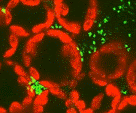Plant Pathology, Department of

Department of Plant Pathology: Faculty Publications
ORCID IDs
Document Type
Article
Date of this Version
2015
Citation
Tatineni, S., McMechan, A. J., Bartels, M., Hein, G. L., and Graybosch, R. A. 2015. In vitro transcripts of wild-type and fluorescent protein-tagged Triticum mosaic virus (family Potyviridae) are biologically active in wheat. Phytopathology 105:1496-1505.
Abstract
Triticum mosaic virus (TriMV) (genus Poacevirus, family Potyviridae) is a recently described eriophyid mite-transmitted wheat virus. In vitro RNA transcripts generated from full-length cDNA clones of TriMV proved infectious on wheat. Wheat seedlings inoculated with in vitro transcripts elicited mosaic and mottling symptoms similar to the wildtype virus, and the progeny virus was efficiently transmitted by wheat curl mites, indicating that the cloned virus retained pathogenicity, movement, and wheat curl mite transmission characteristics. A series of TriMV-based expression vectors was constructed by engineering a green fluorescent protein (GFP) or red fluorescent protein (RFP) open reading frame with homologous NIa-Pro cleavage peptides between the P1 and HC-Pro cistrons. We found that GFP-tagged TriMV with seven or nine amino acid cleavage peptides efficiently processed GFP from HC-Pro. TriMV-GFP vectors were stable in wheat for more than 120 days and for six serial passages at 14-day intervals by mechanical inoculation and were transmitted by wheat curl mites similarly to the wild-type virus. Fluorescent protein-tagged TriMV was observed in wheat leaves, stems, and crowns. The availability of fluorescent protein-tagged TriMV will facilitate the examination of virus movement and distribution in cereal hosts and the mechanisms of cross protection and synergistic interactions between TriMV and Wheat streak mosaic virus.


Comments
U. S. government work.